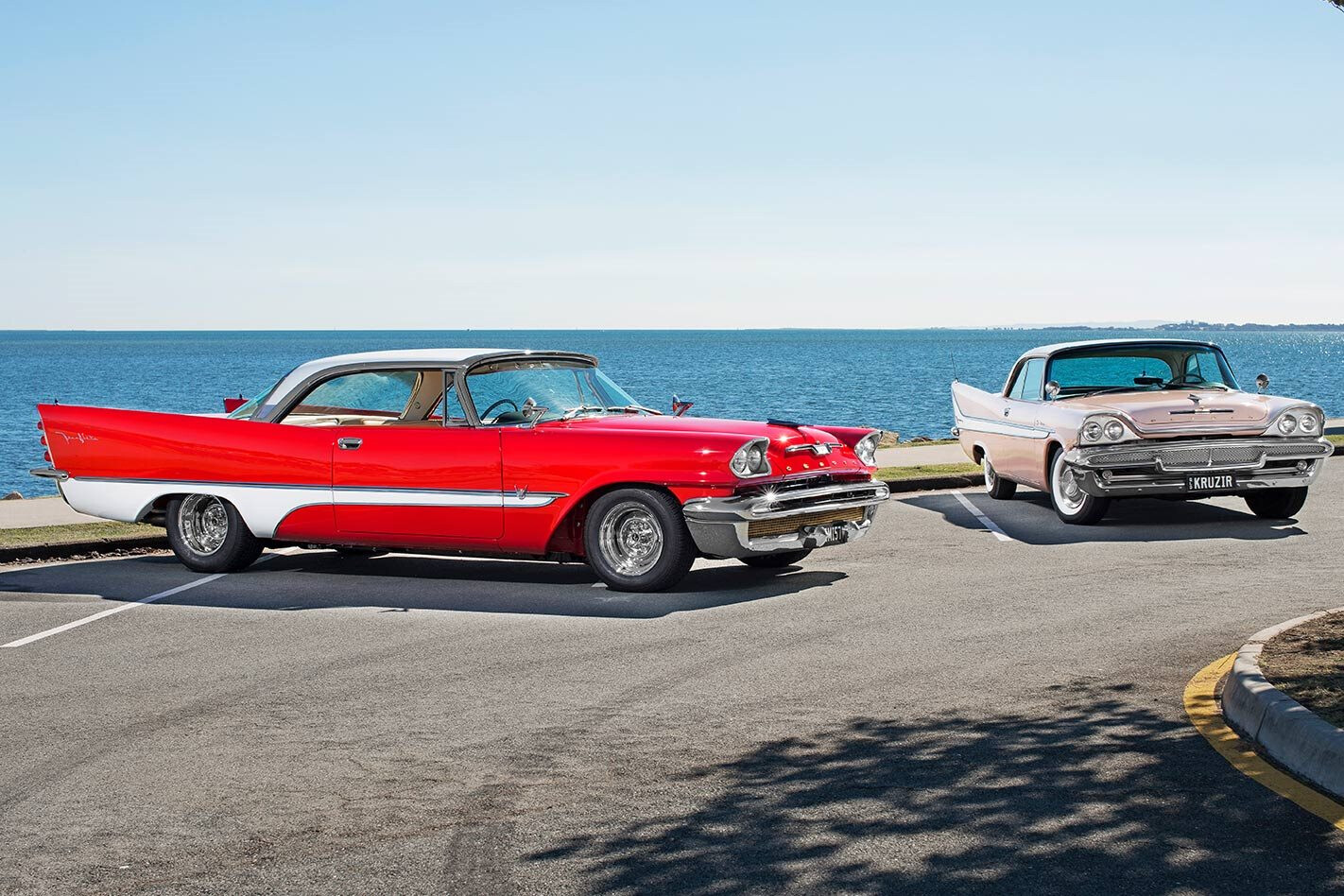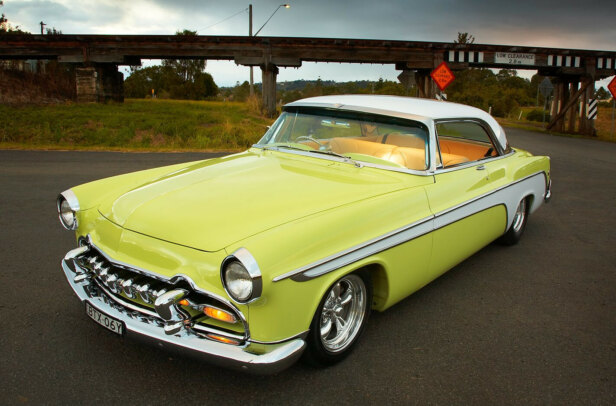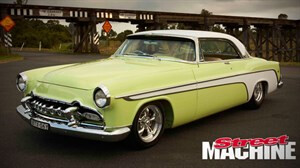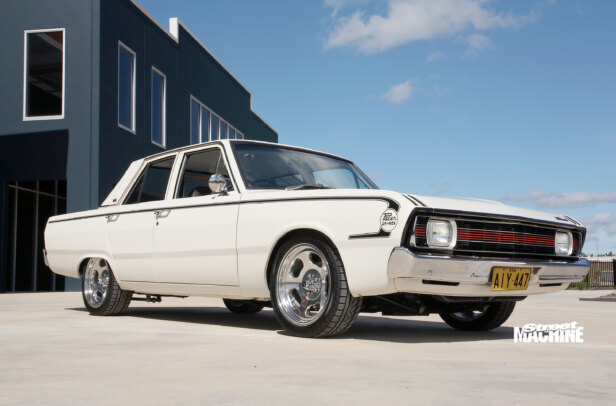This article was originally published in the November 2013 issue of Street Machine magazine
WE’RE all prone to dropping some high-impact four-letter words from time to time, but drop the H-bomb — Hemi — amongst like-minded car folk and you’ll be sure to draw attention.
For nearly 60 years the Chrysler Hemi V8 has been stoically worshipped. Think Hemi and your brain conjures images of wheelstanding rails, Willys Gassers and stuffed-full Cuda engine bays, but that’s only part of the story.
The Chrysler Corporation housed various incarnations of this donk in some of the most beautiful bodyshells ever designed. As seen with Bob and Terry Hamilton’s 1957 DeSoto Fireflite.
“I always wanted a Hemi-powered car, plain and simple,” Bob explains. “The DeSoto hardtop is such a beautiful shape that with a Hemi on board it’s the perfect mix of form and function.”
These aren’t the words of a starstruck novice or one-eyed Pentastar fan, either — Bob is well versed in the art of vehicle restoration and modification, with many droolworthy rides sharing shed space.
He’s most famous as the pilot of the Captain Nitrous FJ drag car and his BMW M3-powered FJ streeter (SM, Dec 04) but there’s much more.
“I have a real motley collection of cars, including a vintage era Rolls, a Buick, HT Monaro, a big-horsepower XW GT tribute and a number of BMWs and early Holdens. I don’t have any brand allegiance, I just like things a bit different.”
So it sort of fits in but why specifically a ’57 Fireflite? “I saw a DeSoto ad with Groucho Marx years ago — ‘With prices starting just above the lowest’ — and it’s played on my mind ever since.”
A production run of 7217 makes it a rare car even in the US, but Bob was fortunate to source one locally in 2005, through AutoArt in Melbourne.
“It was in fairly rough shape when we got it home, plenty of dents and scrapes and the 341 Hemi had thrown a rod way back in ’65, so it was well and truly locked up. Its best attribute, however, was that it was pretty much complete and didn’t have insurmountable rust — that’s the real killer with these cars and the main reason why there’s so few left.”
It sat for a few years before Bob engaged legendary Aussie customiser Paul Kelly to restore the DeSoto’s beautiful curves. The car was stripped and the metal craft began at Paul’s Smooth Customs workshop.
The boot floor and rear pan were replaced, with repairs needed to the bottom of the rear quarters, the rear floor and a couple of other spots. The quarters were bare-metalled before the bodyshell was sent for a thorough sandblast and epoxy prime.
Around this time Paul fell ill and was sidelined, so another experienced panel beater, John Dawson, was dragged out of retirement, with Karl Zerner stepping in as project manager.
“I was so lucky to have such talented craftsmen to work on the car,” Bob says. “Without their dedication and interest in the project it would never have been finished.”
With the acres of metal prepped to perfection, John’s brother Ian was called upon to lavish the big girl in litres of Hip Hop Red and Frosty White two-pack, the same basic combo spied by Bob in colour ads for the DeSoto years earlier.
Fresh glass and refurbished chrome complete the exterior detailing and accentuate the swoopy rear fins and stacked tail-lights that define the era.
Let’s face it, there’s only one real option to power a car this size, even if only for proportional reasons, and that is the aforementioned Hemi.
Instead of the ‘baby’ 341-cube version, Bob went with a 392 screwed together by Karl Zerner from KmanZ Speed Shop. The 392 is the hot rodder’s Hemi; it’s the model that made this configuration famous before the total domination of the mighty 426, but interestingly was only in production for 12 months across 1957-58.
With the DeSoto being virtually a badge-engineered Chrysler and sharing the same underpinnings as the famous Chrysler 300, fitment was never going to be an issue. Karl began by freshening an original 392 block and filling it with a reground stock crank, Molnar H-beam rods, chrome-moly rings and Ross forged pistons that retain a 10:1 PULP-friendly compression ratio.
An Ivan Tighe custom roller cam plugs the centre tunnel while Trend pushrods bump their way north to ported and polished cast 392 heads running Isky valves and springs. A Hotheads tunnel ram is topped by twin 580 Holley four-barrels, while custom-made air cleaner cans mimic the original crossram tins of the DeSoto Adventurer and Chrysler 300, and help to balance the famous elephant Hemi tappet covers.
Work was progressing at a steady rate when tragedy struck: Bob’s main man on the project, John Dawson, was killed in a vintage plane crash.
“John was a good mate and such a talented man; you can’t look at the car and not think of him. We had to push on; he would’ve wanted us to finish the build so we dedicated it to him.”
With Paul Kelly on the road to recovery, he stepped back in to fill the breach. “Paul’s a clever guy and was just who we needed to get the ’Flite over the line. Paul was responsible for much of the right-hand drive conversion, which included an absolute jigsaw of a dash build. But RHD was a must with what I intend to do with the car — I’ll feel more in control steering from the familiar side in case it steps out under power!”
Swing open the big coupe doors and you’re immediately met by an expanse of sumptuous tan leather-textured vinyl. Stitched by Rod’s Trim Shop, it was chosen over traditional white for ease of maintenance and to match the red hue for a Ferrari-esque colour combo.
The Kelly-made door cards feature handmade bolsters and the material was embossed with the Desoto Adventurer logo in-house using machined plates, heat and a bearing press.
“We spent countless hours getting the entire dash assembly just right,” Bob says. “Everything had to look period but still be functional and comfortable. The Vintage Air a/c was tucked up as high as possible, custom vents were made based around VE Commodore items and all gauges were reconditioned.
“The steering wheel clock was an accessory item for the ’57 but these were ‘unprocurable’. Thanks to the DeSoto devotees at the Forward Look Forum, I was told the VW steering wheel clock was identical, so one was modified to fit the DeSoto wheel and mounted in a custom housing.”
Having overcome adversity and navigated through the many twists and bends of a major build, the DeSoto finally hit the road in July this year.
“I have tried very hard to be thorough but Murphy still managed to stick a spanner in the works here and there,” Bob laughs. “Thank God for eBay. This isn’t the sort of car you’ll find parts for at your local swap or over the counter, so I spent numerous hours searching for secondhand and NOS Chrysler parts to finish the project. I was extremely lucky to find some of the missing chrome trim, but hey, it’s all part of the adventure.”
You may be thinking this’ll make a great cruiser for leisurely Sunday outings, and you’d be right but there’s more to this DeSoto’s future than hours of light throttle and pampering.
“It’s easy to drive and steers like magic, and although it was never meant to be a race car you’ll see it cop a hiding at the Nostalgia Drags,” Bob says. “It’s a 50s muscle car and will be treated as such. But this is only part A; wait ’til you see it towing part B — a matching red and white 1957 Bell Boy Banshee speedboat.”
’57 DESOTO IN THE BUILD
Once Paul Kelly paint stripped the body, the real extent of the damage was revealed. This included a big swipe down the whole right-hand side and ashunt to the left-hand rear quarter that had been repaired with bog back in the day.
Racked up and ready to go. “They were an extremely rusty DeSoto model,” Bob says. “They leaked like sieves and trapped water in the weirdest of places, which of course is a really bad combination!”
The expansive quarters were the most troublesome repair due to an indecent number of dents and scrapes. Perfectionist panel beater John Dawson used a metre-long speed file to restore the factory lines.
The original dash was sliced and diced into numerous pieces, then rearranged to form the basis of the RHD conversion. The nightmare stems from the fact that the dash and fittings are an asymmetric work of art, designed to be LHD only.
The master of all trades, Paul Kelly from Smooth Customs made the fibreglass doorcards along with a great many custom one-off components that were needed to perfect the right-hand drive conversion.
In real life all this panel and paintwork takes more time than those self-rebuilding scenes from the movie Christine — and yes, we know it’s not the correct make or year. Reassembling the painted body was a painstaking process.
BOB & TERRY HAMILTON
1957 DESOTO FIREFLITE HARDTOP
Colour: Hip Hop Red/Frosty White
ENGINE
Make: Chrysler 392 Hemi
Carbs: Twin 580 Hollies
Intake: Hotheads tunnel ram
Heads: Factory-cast 392, ported
Crank: Stock, reground
Rods: Molnar H-beam
Pistons: Ross forged
Camshaft: Tighe custom roller
Ignition: MSD 6AL and Pro Billet distributor
Cooling: Stock radiator re-cored, mechanical and electric fans
Exhaust: Custom extractors, twin mandrel-bent three-inch system
DRIVELINE
Gearbox: Chrysler 727 TorqueFlite
Shifter: Factory push-button
Diff: Nine-inch, 3.7, nodular centre, LSD
UNDERNEATH
Front: Torsion bar, lowered
Rear: Reset leaf springs
Shocks: Koni adjustable
Steering: Aftermarket pump, Toyota Crown box
Brakes: Hoppers Stoppers 290mm discs with twin-piston calipers (f), rebuilt 9in drums (r)
WHEELS & TYRES
Rims: Chrome Chevelle centres, 15×8 (f), 15×10 (r)
Rubber: Mastercraft Avengers, 235/60 (f), 295/50 (r)




Comments